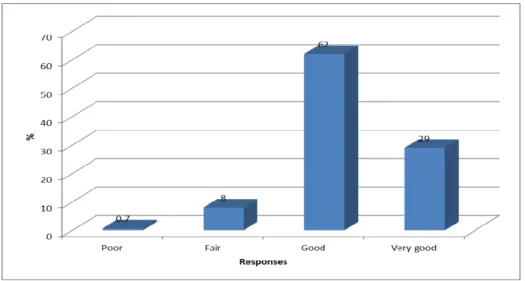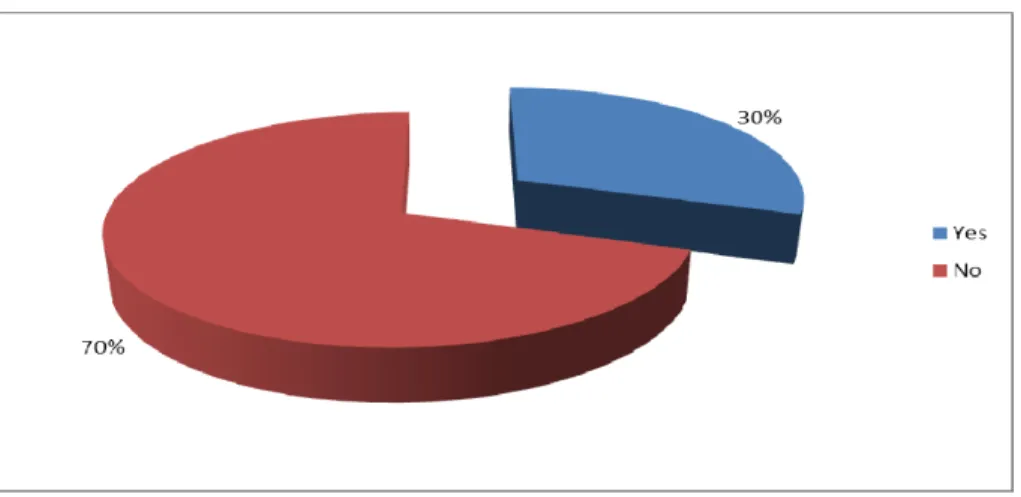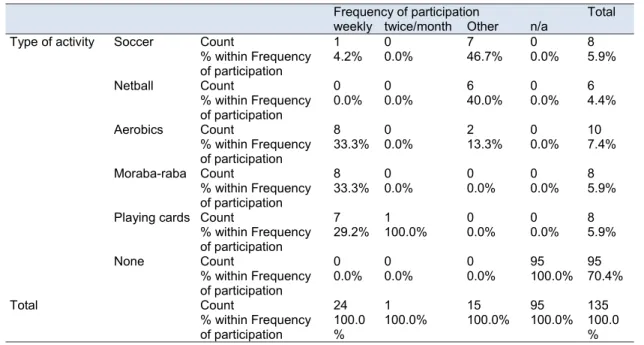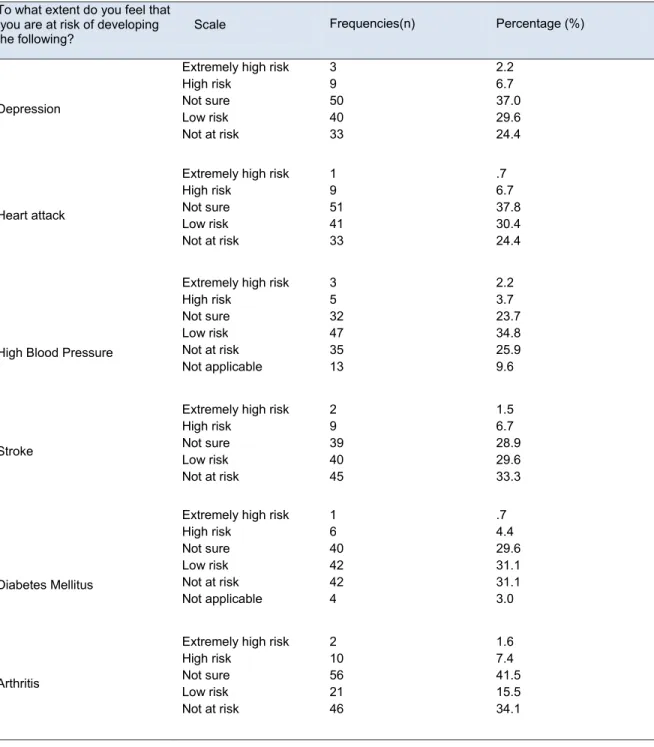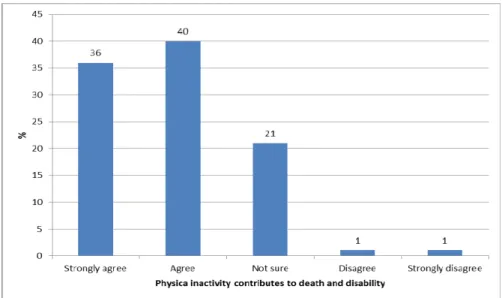The aim of the study was to determine the perceived factors that influence participation of non-medical staff members in workplace sports and recreation at Elim Hospital, using the constructs of the Health Belief Model. The study revealed that the rate/level of participation in workplace sports and recreation among non-medical staff members at Elim Hospital was low (30%).
Introduction
More than 60% of the world's population is not achieving the recommended amount of physical activity needed to achieve health benefits (WHO, 2004). The Head of Department (HOD) recommended adopting the Sports and Recreation Policy (SRP) for the department to ensure that employees have the opportunity to take care of their physical well-being (Limpopo Department of Health and Social Development, 2009 ).
Problem statement
According to Gungaphul, Kassean & Ramnarain (2012) it is important to monitor and evaluate workplace sports and recreation programs to gauge their effectiveness in creating a healthy workplace and therefore develop appropriate strategies to meet the objectives of the employers as well as the reach employees. . Considering the amount of time adults spend in the workplace, as well as the burden of lifestyle chronic diseases in developing countries such as South Africa, this study therefore aims to identify the perceived factors that influence participation of non-medical staff in workplace sports and recreation at Elim Hospital.
Rationale for the study
Significance of the study
Aim and objectives of the study
Aim of the study
Study objectives
This chapter provides an overview of participation in sport and recreation at the workplace. Even in South Africa, participation rates in workplace sport and recreation are low. Perceived factors influencing participation in sport and recreation at work among non-medical staff members at Elim Hospital.
Perceived factors influencing participation in workplace sports and recreation among non-medical staff members at Elim-Vhembe District Hospital. My research topic is: "Perceived factors affecting participation in sports and recreation at the workplace among non-medical staff members at Elim Hospital - Vhembe District". To assess the level/rate of participation in sport and recreation in the workplace among non-medical staff members of Elim Hospital.
To describe the non-medical staff's perceived benefits of participating in workplace sport and recreation. To identify non-medical staff members' cues to action for participation in workplace sport and recreation. To identify non-medical staff member's perceived barriers to participation in workplace sport and recreation at Elim Hospital.
My research topic is: "Perceived factors influencing participation in workplace sports and recreation among non-medical staff at Elim Hospital-Vhembe District". To identify non-medical staff's cues to action for participation in workplace sport and recreation.
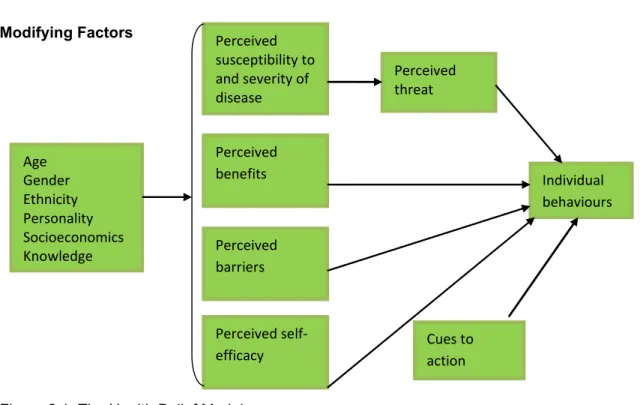
Definition of terms and concepts
Conclusion
The explanation of the problem, meaning, rationale, purpose and objectives of the study were presented. The conceptual framework was used as a guideline for the assessment of perceived factors influencing participation in work and recreation.
Literature review
- Introduction
- Data-based literature
- Overview of participation in physical activity worldwide
- Socio demographic factors associated with participation
- Perceived susceptibility to and severity of non-communicable diseases…. 10
- Cues to action
- Perceived barriers to participation in workplace sports and recreation
- Legislation and policy framework for Employee Wellness
- Consequences of physical inactivity
- Conceptual literature
- Conclusion
The study found that the level of participation in health promotion at the workplace was below 50%. Results from a survey conducted by the NDSR in South Africa to determine participation patterns in sport and recreation showed participation rates of 42.6% for males and 11.2% for females (NDSR, 2005).
Methodology
- Introduction
- Study design
- Study setting
- Study population and sample
- The study population
- Sampling
- Data collection instrument
- Pre-test
- Data collection process
- Data analysis
- Ethical issues
- Validity and reliability
- Validity
- Reliability
- Conclusion
The study population included all non-medical staff members who were permanently employed by the Limpopo Department of Health at Elim Hospital at the time of the study. Since the total number of non-medical staff members at Elim Hospital was 247, a total population was used in the study. The pre-test was conducted at the same study site using non-medical staff members from the three staff categories, who were subsequently excluded from the main study.
Permission to conduct the study was obtained from the Limpopo Department of Health (Provincial and District) (Appendix E and Appendix G) as well as from the Chief Executive Officer (CEO) of Elim Hospital (Appendix J). Participation in the research was therefore voluntary and the researcher disclosed all important information related to the study before the start of the study. Participants could withdraw from the study at any time during the study.
This was done by administering the tool twice to 10% of the study population at Elim Hospital, one week apart.

Results
- Introduction
- Descriptive Statistics
- Socio-demographic characteristics of respondents
- Participation in sports and recreation
- Perceived susceptibility
- Perceived seriousness / severity
- Perceived benefits
- Cues to action
- Perceived barriers
- Inferential statistics
- Association between socio-demographic factors and participation
- Association between health-related factors and participation
- Association between perceived barriers and occupation category
- Conclusion
The relationship between the following socio-demographic factors and participation in sports and recreation is presented and analyzed; age, gender, education level, profession category and work experience. Forty-five point three (45%) were male and 52 (55%) were found not to participate in workplace sports and recreation. Further, the table shows that there was no significant relationship between respondents' gender and participation in sports and recreation at the workplace (P = 0.67 >0.05).
As indicated in the table below, there is a significant relationship between the age of the respondents and participation in sports and recreation (P. The table further shows that there is a significant relationship between the occupational category of the respondents and participation in sports and recreation at the workplace (P. Between the years of experience of the respondents and participation in sports and recreation at the workplace had no significant relationship (P = .771>0.05).
However, there was no significant relationship between perception about health of respondents and participation in workplace sports and recreation (P = .135 > 0.05). As shown in 4.15 below, there was no significant relationship between respondents' awareness of sport and recreation policy and participation in workplace sport and recreation (P = .316> 0.05). Most participants in this study were aware of the health benefits of sport and recreation.
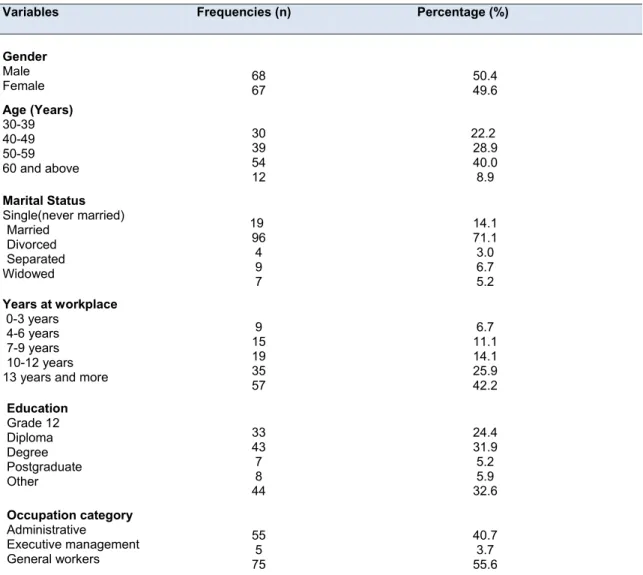
Discussion, Recommendation and Conclusion
Introduction
Discussion
The result of this current study also supports what was reported in other studies conducted in South Africa, which revealed low participation in workplace sport and recreation. From the current study, there was a significant correlation between the age of the participants and participation in workplace sports and recreation (P. In this study, the correlation between the occupational category of respondents and participation in workplace sports and recreation was significant (P.
This may be a contributing factor to low participation in sports and recreation at Elim Hospital. However, from this current study, there was no significant relationship between awareness of respondents about the policy and participation in workplace sports and recreation (P = 0.316> 0.05). Several other studies have also reported a busy work schedule as a barrier to participating in workplace sports and.
However, no significant relationship was found between the respondents' busy work schedule and participation in sports and recreation at the workplace (P = .938>0.05).
Recommendation
Although a busy work schedule was reported by all three categories of staff that were part of this study, executive management was most affected, with 20% of executive management strongly agreeing and 40% agreeing that they do not participate due to of the busy work schedule. This supports findings from a longitudinal study conducted among university employees in East Carolina, which found that only 10.4% of managers and leadership team members participated in the program; busy work schedules were cited as a reason for poor participation (Person et al., 2010). This may be due to the additional responsibility that executive managers have in a hospital setting where they have the responsibility to oversee that everything runs smoothly and therefore they end up not prioritizing sports and recreation.
From the staff structure Elim Hospital 2016, it is clear that there are many vacant positions at Elim Hospital across the various staff categories. This is an indication that the few people currently occupying various positions are overworked and have to go the extra mile to ensure that all work is done, leaving them with no time for sports and recreation due to the workload. When the vacant positions are filled, the employees will be able to take turns to participate in sports and leisure activities.
Of the 16 activities covered in the department's sport and recreation policy, non-medical staff members at Elim Hospital were found to participate in only five (5), so it is necessary to further investigate why people do not engage in the activities others. the activities.
Limitation
Monitor the implementation of the policy regularly to identify challenges experienced at the facility level and therefore provide the necessary support required at the facility level.
Plan for dissemination
Conclusion
Perceived barriers to sport and recreation participation in Botswana: African Journal for Physical, Health Education, Recreation and Dance. Physical activity and risk of stroke in women available at http://stroke.ahajournals.org (Retrieved from. Physical activity, health and well-being - a strategic objective of South Africa's National Sports and Recreation Plan (NSRP).
Do you participate (while working) in any workplace sports and recreation activities mentioned in the Limpopo Ministry of Health Sport and Recreation policy. Which of the following sports/recreational activities covered by the Limpopo Department of Health Sport and Recreation Policy do you participate in during sports days. Please do not answer this question if you are already involved in sports and recreation at work.
The title of my study is "Perceived factors affecting participation in sports and recreation at the workplace among non-medical staff members at Elim Hospital - Vhembe District". To determine the perceived factors influencing the participation of non-medical staff members in workplace sports and recreation at Elim Hospital. The purpose of the study is to determine the perceived factors that influence the participation of non-medical staff members in workplace sports and recreation at Elim Hospital.
Letter to Elim Hospital
Attached: a copy of the letter of approval from the Head of Department (HOD) Limpopo Department of Health, letter of approval from the District Executive Manager Vhembe District Department of Health, as well as the ethical approval certificate from the Higher Degree Committee of the University of Venda.
